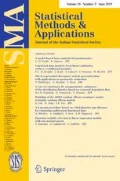Abstract
The aggregate measures of inequality do not display any significant trend in the concentration of equivalent income among the Italian households in the early 2000s. Yet some sizeable shifts in the income distribution seem to suggest that the relative positions of groups of households have changed on the income scale. Through a decomposition analysis of Gini index by income source we find that in the more recent years the income from self-employment is the main disequalizing factor. The decomposition by social groups provides the evidence that it is the group of self-employed and managers who have gained more ground on the income scale.
Similar content being viewed by others
References
Atkinson AB, Brandolini A (2004) I cambiamenti di lungo periodo nelle disuguaglianze di reddito nei paesi industrializzati. Riv Ital degli Econ 3: 389–421
Baldini M (2006) Le famiglie alla prova dei conti. Il. Mulino 426: 708–718
Baldacci E, Tuzi D (2003) Demographic trends and pension system in Italy: an assessment of 1990s reforms. Labour 17: 209–240
Banca d’Italia (2004) Italian Household Budgets in 2002. Supplement to the Statistical Bulletin 12, Roma
Beach CM, Davidson R (1983) Distribution-free statistical inference with Lorenz Curves and income shares. Rev Econ Stud L: 723–735
Boeri T, Brandolini A (2004) The age of discontent: Italian households at the beginning of the decade. G Econ Ann Econ 63: 449–487
Borgarello A, Devicienti F (2006) L’aumento della disuguaglianza dei salari in Italia: premi salariali per le “nuove” skill. Politica Econ 2: 193–232
Brandolini A (1999) The distribution of personal income in post-war Italy: source description, data quality, and the time pattern of income inequality. G Econ Ann Econ 58: 183–239
Brandolini A (2005) La disuguaglianza di reddito in Italia nell’ultimo decennio. Stato Mercato 74: 207–229
Brandolini A, D’Alessio G (2001) Household structure and income inequality. In: del Boca D, Repetto RG(eds) Women work, family and social policies in Italy. Peter Lang, New York
Brandolini A, Cipollone P, Sestito P (2001) Earnings dispersion, low pay and household poverty in Italy, 1977–1998. Temi di discussione del Servizio Studi 427 Banca d’Italia, Roma
Dagum C (1987) Measuring the economic affluence between populations of income receivers. J Bus Econ Stat 1: 5–12
Dagum C (1997) A new approach to the decomposition of the gini income inequality ratio. Empir Econ 22: 515–531
Deutsch J, Silber J (1997) Gini’s”Transvariazione” and the measurement of distance between distributions. Empir Econ 22: 547–554
Gottschalk P, Smeeding TM (1997) Cross-national comparisons of earnings and income inequality. J Econ Lit XXXV: 633–687
Jenkins SP (1995) Accounting for inequality trends: decomposition analyses for the UK, 1971–86. Economica 62: 29–63
Kakwani NC (1977) Applications of Lorenz Curves in economic analysis. Econometrica 3: 719–727
Manacorda M (2004) Can the scala mobile explain the fall and rise of earnings inequality in Italy? A semiparametric analysis, 1977–1993. J Labour Econ 3: 585–613
Ogwang T (2000) A convenient method of computing the Gini index and its standard error. Oxf Bull Econ Stat 1: 123–129
Quintano C, Castellano R, Regoli A (2004) How the under-reporting affects the income data from a household survey. In: Proceedings of the European Conference on Quality and Methodology in Official Statistics (Q2004) [on CD-ROM], Mainz, Germany, 24–26 May, 2004
Wan GH (2001) Changes in regional inequality in rural China: decomposing the Gini index by income sources. Aust J Agric Resour Econ 3: 361–381
Wan GH (2001) Decomposing changes in the Gini index by factor components. Appl Econ Lett 8: 1–3
Wan GH (2004) Accounting for income inequality in rural China: a regression-based approach. J Comp Econ 32: 348–363
Wan GH, Zhou Z (2005) Income inequality in rural China. Regression-based decomposition using household data. Rev Dev Econ 1: 107–120
Wan GH (2007) Understanding regional poverty and inequality trends in China: methodological issues and empirical findings. Rev Income Wealth 1: 25–34
Yao S (1997) Decomposition of Gini coefficients by income factors: a new approach and application. Appl Econ Lett 4: 27–31
Yao S (1999) On the decomposition of Gini coefficients by population class and income source: a spreadsheet approach and application. Appl Econ 31: 1249–1264
Author information
Authors and Affiliations
Corresponding author
Additional information
This work has been debated by the three Authors under the coordination of Claudio Quintano. Rosalia Castellano has written Sect. 1, while Andrea Regoli has written Sects. 2 to 6.
Rights and permissions
About this article
Cite this article
Quintano, C., Castellano, R. & Regoli, A. Evolution and decomposition of income inequality in Italy, 1991–2004. Stat Methods Appl 18, 419–443 (2009). https://doi.org/10.1007/s10260-008-0101-0
Accepted:
Published:
Issue Date:
DOI: https://doi.org/10.1007/s10260-008-0101-0



